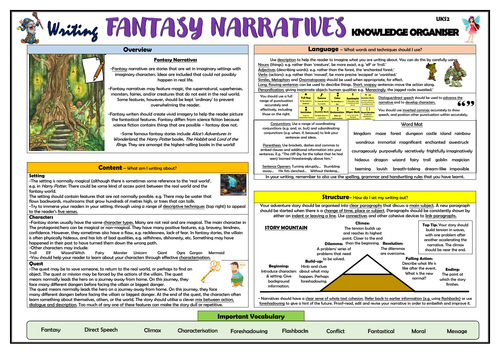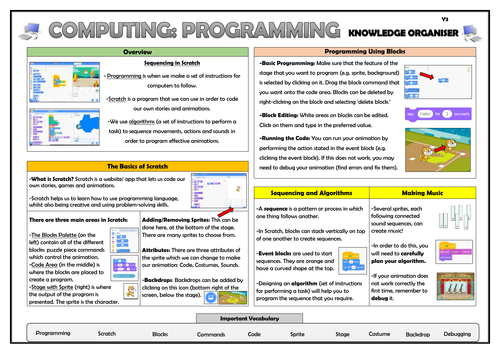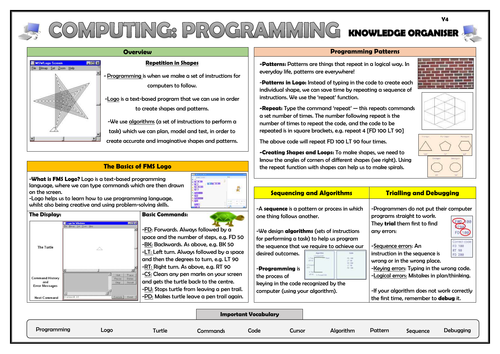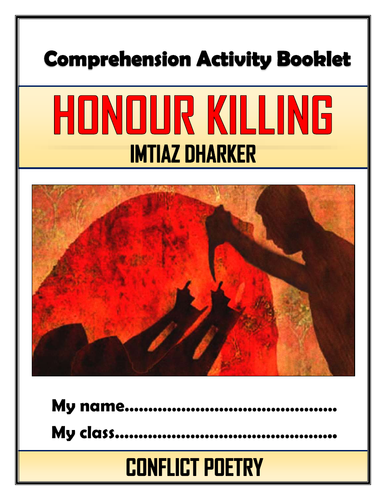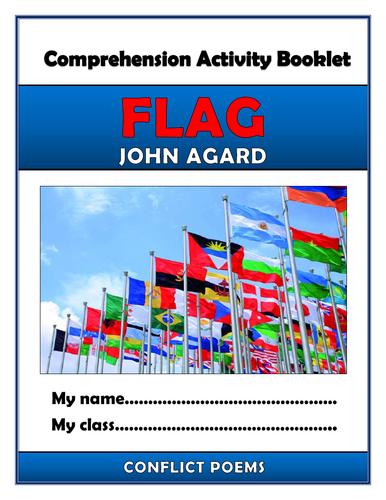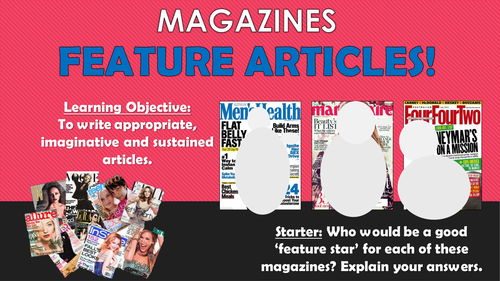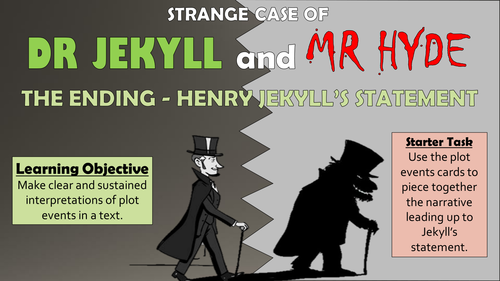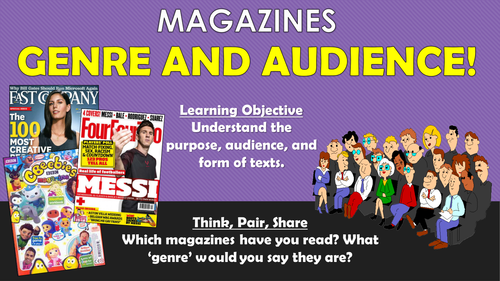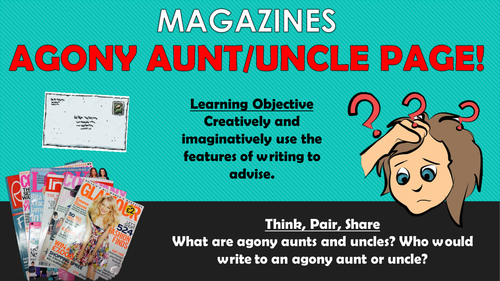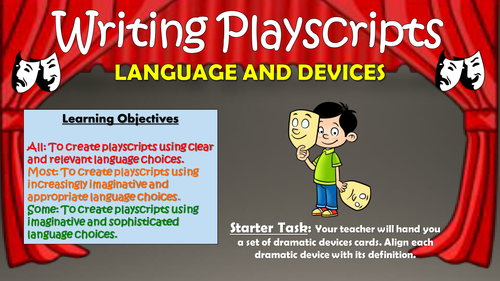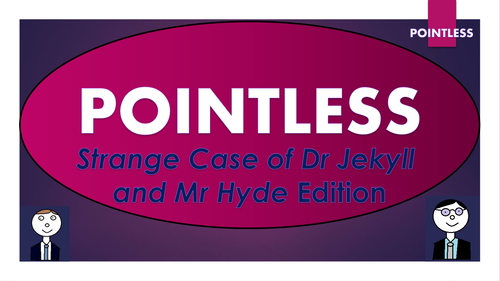
3k+Uploads
1952k+Views
2270k+Downloads
Whole school

Writing Fantasy Narratives - Lower KS2 Knowledge Organiser!
This clear, detailed and visually-appealing resource offers a complete reference point for year 3/4 children when writing fantasy narratives. The organiser is also perfect for teachers, parents and English subject leaders - aiding their planning and supporting of children’s knowledge development for this writing text type.
The organiser has a particular focus on the content, language and structural features required to write effective fantasy stories at lower KS2. It contains distinct sections covering:
-Fantasy Overview;
-Content: Settings, Characters, and Quests;
-Language: Descriptive Devices, Dialogue, Conjunctions, Punctuation Checklist and Word Mat;
-Structure - Titles, Structure Mountains and other tips;
-Key Vocabulary
The content is fully aligned with the age-related expectations for year 3/4 children in writing. The resource is designed to be printed onto A3, and is provided as both a PDF and a Word version (so that you can edit if you want to). All images used are licensed for commercial use and are cited on a separate document (included).

Writing Fantasy Narratives - Upper KS2 Knowledge Organiser!
This clear, detailed and visually-appealing resource offers a complete reference point for year 5/6 children when writing fantasy narratives. The organiser is also perfect for teachers, parents and English subject leaders - aiding their planning and supporting of children’s knowledge development for this writing text type.
The organiser has a particular focus on the content, language and structural features required to write effective fantasy stories at upper KS2. It contains distinct sections covering:
-Fantasy Overview;
-Content: Settings, Characters, and Quests;
-Language: Descriptive Devices, Dialogue, Conjunctions, Punctuation Checklist and Word Mat;
-Structure - Titles, Structure Mountains and other tips;
-Key Vocabulary
The content is fully aligned with the age-related expectations for year 5/6 children in writing. The resource is designed to be printed onto A3, and is provided as both a PDF and a Word version (so that you can edit if you want to). All images used are licensed for commercial use and are cited on a separate document (included).

Year 3 Computing - Programming - Sequencing in Scratch - Knowledge Organiser!
This clear, detailed and visually-appealing resource offers a complete reference point for Year 3 children, teachers and parents covering knowledge relating to ‘Programming’ as a part of their computing learning.
The organiser has a particular focus on introducing children to how to use the basic functions of scratch, including how to sequence motions and sounds. It contains comprehensive sections on:
-Overview;
-The Basics of Scratch;
-Programming Using Blocks;
-Sequencing and Algorithms;
-Making Music;
-Key Vocabulary.
The content is fully aligned with the age-related expectations for Year 3 children in computing. The resource is designed to be printed onto A3, and is provided as both a PDF and a Word version (so that you can edit if you want to). All images used are licensed for commercial use and are cited on a separate document (included).

Year 4 Computing - Programming - Repetition in Shapes - Knowledge Organiser!
This clear, detailed and visually-appealing resource offers a complete reference point for Year 4 children, teachers and parents covering knowledge relating to ‘Programming’ as a part of their computing learning.
The organiser has a particular focus on introducing children to how to use the basic functions of MS Logo, including how to program shapes and patterns. It contains comprehensive sections on:
-Overview;
-The Basics of MS Logo;
-Programming Patterns;
-Sequencing and Algorithms;
-Trialling and Debugging;
-Key Vocabulary.
The content is fully aligned with the age-related expectations for Year 4 children in computing. The resource is designed to be printed onto A3, and is provided as both a PDF and a Word version (so that you can edit if you want to). All images used are licensed for commercial use and are cited on a separate document (included).
Bundle

OCR Conflict Poetry Comprehension Activity Booklets!
These 16-page resource booklets contain a wide range of challenging and engaging comprehension activities for use throughout the reading of all 15 of the OCR ‘Conflict’ poems from the newest anthology. Teachers have found the activities particularly useful throughout teaching, or for exam revision or guided reading sessions. They are perfect for aiding the progress of students towards meeting the key English Literature assessment objectives. Students have found these resources extremely engaging, and it is clearly highlighted within each task regarding which assessment strands the task is designed to demonstrate.
Each booklet is provided in both Word (to allow for easy editing) and PDF (to ensure for consistency of formatting between computers).
Activities across the booklets are as consistent, to provide an equal understanding of each poem, and include (amongst many others):
‘Analysing Context’ - helping students to ‘Show understanding of the relationships between texts and the contexts in which they were written.’
‘Analysing Subject Matter, Language and Structure’ - to help students to ‘Analyse the language, form and structure used by a writer to create meanings and effects, using relevant subject terminology where appropriate.’
‘Diary Entry’ - to help students to ‘Use a range of vocabulary and sentence structures for clarity, purpose and effect, with accurate spelling and punctuation. Make an informed personal response, recognising that other responses to a text are possible and evaluating these.’
‘The Speaker’ - to help students to ‘Read, understand and respond to texts. Students should be able to: maintain a critical style and develop an informed personal response use textual references, including quotations, to support and illustrate interpretations.’

Cousin Kate Comprehension Activities Booklet!
This 16-page resource booklet contains a wide range of age-appropriate, engaging, and meaningful comprehension activities for use throughout the reading of Christina Rossetti’s power and conflict poem ‘Cousin Kate.’ Teachers have found them particularly useful throughout teaching, or for exam revision or guided reading sessions. They are perfect for aiding the progress of students towards meeting the key English Literature assessment objectives - suitable for all examining bodies. Students have found these resources extremely engaging, and it is clearly highlighted within each task regarding which assessment strands the task is designed to demonstrate.
Activities within the booklet include:
‘Analysing Context’ - helping students to ‘Show understanding of the relationships between texts and the contexts in which they were written.’
‘Analysing Subject Matter, Language and Structure’ - to help students to ‘Analyse the language, form and structure used by a writer to create meanings and effects, using relevant subject terminology where appropriate.’
‘Diary Entry’ - to help students to ‘Use a range of vocabulary and sentence structures for clarity, purpose and effect, with accurate spelling and punctuation. Make an informed personal response, recognising that other responses to a text are possible and evaluating these.
‘The Speaker’ - to help students to ‘Read, understand and respond to texts. Students should be able to: maintain a critical style and develop an informed personal response use textual references, including quotations, to support and illustrate interpretations.’
Plus many, many more activities! I’ve also added it as a PDF in case the formatting differs on your computer.
Bundle

Edexcel Conflict Poetry Comprehension Activity Booklets!
These 16-page resource booklets contain a wide range of challenging and engaging comprehension activities for use throughout the reading of all 15 of the Edexcel ‘Conflict’ poems from the newest anthology. Teachers have found the activities particularly useful throughout teaching, or for exam revision or guided reading sessions. They are perfect for aiding the progress of students towards meeting the key English Literature assessment objectives. Students have found these resources extremely engaging, and it is clearly highlighted within each task regarding which assessment strands the task is designed to demonstrate.
Each booklet is provided in both Word (to allow for easy editing) and PDF (to ensure for consistency of formatting between computers).
Activities across the booklets are as consistent, to provide an equal understanding of each poem, and include (amongst many others):
‘Analysing Context’ - helping students to ‘Show understanding of the relationships between texts and the contexts in which they were written.’
‘Analysing Subject Matter, Language and Structure’ - to help students to ‘Analyse the language, form and structure used by a writer to create meanings and effects, using relevant subject terminology where appropriate.’
‘Diary Entry’ - to help students to ‘Use a range of vocabulary and sentence structures for clarity, purpose and effect, with accurate spelling and punctuation. Make an informed personal response, recognising that other responses to a text are possible and evaluating these.’
‘The Speaker’ - to help students to ‘Read, understand and respond to texts. Students should be able to: maintain a critical style and develop an informed personal response use textual references, including quotations, to support and illustrate interpretations.’

Honour Killing Comprehension Activities Booklet!
This 16-page resource booklet contains a wide range of challenging and engaging comprehension activities for use throughout the reading of Imtiaz Dharker’s conflict poem 'Honour Killing.’ Teachers have found them particularly useful throughout teaching, or for exam revision or guided reading sessions. They are perfect for aiding the progress of students towards meeting the key English Literature assessment objectives - suitable for all examining bodies. Students have found these resources extremely engaging, and it is clearly highlighted within each task regarding which assessment strands the task is designed to demonstrate.
It is provided in both Word (to allow for easy editing) and PDF (to ensure for consistency of formatting between computers).
Activities within the booklet include (amongst many others):
‘Analysing Context’ - helping students to ‘Show understanding of the relationships between texts and the contexts in which they were written.’
‘Analysing Subject Matter, Language and Structure’ - to help students to ‘Analyse the language, form and structure used by a writer to create meanings and effects, using relevant subject terminology where appropriate.’
‘Diary Entry’ - to help students to ‘Use a range of vocabulary and sentence structures for clarity, purpose and effect, with accurate spelling and punctuation. Make an informed personal response, recognising that other responses to a text are possible and evaluating these.’
‘The Speaker’ - to help students to ‘Read, understand and respond to texts. Students should be able to: maintain a critical style and develop an informed personal response use textual references, including quotations, to support and illustrate interpretations.’

Phrase Book Comprehension Activities Booklet!
This 16-page resource booklet contains a wide range of challenging and engaging comprehension activities for use throughout the reading of Jo Shapcott’s conflict poem 'Phrase Book.’ Teachers have found them particularly useful throughout teaching, or for exam revision or guided reading sessions. They are perfect for aiding the progress of students towards meeting the key English Literature assessment objectives - suitable for all examining bodies. Students have found these resources extremely engaging, and it is clearly highlighted within each task regarding which assessment strands the task is designed to demonstrate.
It is provided in both Word (to allow for easy editing) and PDF (to ensure for consistency of formatting between computers).
Activities within the booklet include (amongst many others):
‘Analysing Context’ - helping students to ‘Show understanding of the relationships between texts and the contexts in which they were written.’
‘Analysing Subject Matter, Language and Structure’ - to help students to ‘Analyse the language, form and structure used by a writer to create meanings and effects, using relevant subject terminology where appropriate.’
‘Diary Entry’ - to help students to ‘Use a range of vocabulary and sentence structures for clarity, purpose and effect, with accurate spelling and punctuation. Make an informed personal response, recognising that other responses to a text are possible and evaluating these.’
‘The Speaker’ - to help students to ‘Read, understand and respond to texts. Students should be able to: maintain a critical style and develop an informed personal response use textual references, including quotations, to support and illustrate interpretations.’

Punishment - Seamus Heaney - Comprehension Activities Booklet!
This 16-page resource booklet contains a wide range of challenging and engaging comprehension activities for use throughout the reading of Seamus Heaney’s conflict poem 'Punishment.’ Teachers have found them particularly useful throughout teaching, or for exam revision or guided reading sessions. They are perfect for aiding the progress of students towards meeting the key English Literature assessment objectives - suitable for all examining bodies. Students have found these resources extremely engaging, and it is clearly highlighted within each task regarding which assessment strands the task is designed to demonstrate.
It is provided in both Word (to allow for easy editing) and PDF (to ensure for consistency of formatting between computers).
Activities within the booklet include (amongst many others):
‘Analysing Context’ - helping students to ‘Show understanding of the relationships between texts and the contexts in which they were written.’
‘Analysing Subject Matter, Language and Structure’ - to help students to ‘Analyse the language, form and structure used by a writer to create meanings and effects, using relevant subject terminology where appropriate.’
‘Diary Entry’ - to help students to ‘Use a range of vocabulary and sentence structures for clarity, purpose and effect, with accurate spelling and punctuation. Make an informed personal response, recognising that other responses to a text are possible and evaluating these.’
‘The Speaker’ - to help students to ‘Read, understand and respond to texts. Students should be able to: maintain a critical style and develop an informed personal response use textual references, including quotations, to support and illustrate interpretations.’

Partition - Comprehension Activities Booklet!
This 16-page resource booklet contains a wide range of challenging and engaging comprehension activities for use throughout the reading of Sujata Bhatt’s conflict poem 'Partition.’ Teachers have found them particularly useful throughout teaching, or for exam revision or guided reading sessions. They are perfect for aiding the progress of students towards meeting the key English Literature assessment objectives - suitable for all examining bodies. Students have found these resources extremely engaging, and it is clearly highlighted within each task regarding which assessment strands the task is designed to demonstrate.
It is provided in both Word (to allow for easy editing) and PDF (to ensure for consistency of formatting between computers).
Activities within the booklet include (amongst many others):
‘Analysing Context’ - helping students to ‘Show understanding of the relationships between texts and the contexts in which they were written.’
‘Analysing Subject Matter, Language and Structure’ - to help students to ‘Analyse the language, form and structure used by a writer to create meanings and effects, using relevant subject terminology where appropriate.’
‘Diary Entry’ - to help students to ‘Use a range of vocabulary and sentence structures for clarity, purpose and effect, with accurate spelling and punctuation. Make an informed personal response, recognising that other responses to a text are possible and evaluating these.’
‘The Speaker’ - to help students to ‘Read, understand and respond to texts. Students should be able to: maintain a critical style and develop an informed personal response use textual references, including quotations, to support and illustrate interpretations.’

Lament Comprehension Activities Booklet!
This 16-page resource booklet contains a wide range of challenging and engaging comprehension activities for use throughout the reading of Gillian Clarke’s conflict poem 'Lament.’ Teachers have found them particularly useful throughout teaching, or for exam revision or guided reading sessions. They are perfect for aiding the progress of students towards meeting the key English Literature assessment objectives - suitable for all examining bodies. Students have found these resources extremely engaging, and it is clearly highlighted within each task regarding which assessment strands the task is designed to demonstrate.
It is provided in both Word (to allow for easy editing) and PDF (to ensure for consistency of formatting between computers).
Activities within the booklet include (amongst many others):
‘Analysing Context’ - helping students to ‘Show understanding of the relationships between texts and the contexts in which they were written.’
‘Analysing Subject Matter, Language and Structure’ - to help students to ‘Analyse the language, form and structure used by a writer to create meanings and effects, using relevant subject terminology where appropriate.’
‘Diary Entry’ - to help students to ‘Use a range of vocabulary and sentence structures for clarity, purpose and effect, with accurate spelling and punctuation. Make an informed personal response, recognising that other responses to a text are possible and evaluating these.’
‘The Speaker’ - to help students to ‘Read, understand and respond to texts. Students should be able to: maintain a critical style and develop an informed personal response use textual references, including quotations, to support and illustrate interpretations.’

Flag Comprehension Activities Booklet!
This 16-page resource booklet contains a wide range of challenging and engaging comprehension activities for use throughout the reading of John Agard’s conflict poem 'Flag.’ Teachers have found them particularly useful throughout teaching, or for exam revision or guided reading sessions. They are perfect for aiding the progress of students towards meeting the key English Literature assessment objectives - suitable for all examining bodies. Students have found these resources extremely engaging, and it is clearly highlighted within each task regarding which assessment strands the task is designed to demonstrate.
It is provided in both Word (to allow for easy editing) and PDF (to ensure for consistency of formatting between computers).
Activities within the booklet include (amongst many others):
‘Analysing Context’ - helping students to ‘Show understanding of the relationships between texts and the contexts in which they were written.’
‘Analysing Subject Matter, Language and Structure’ - to help students to ‘Analyse the language, form and structure used by a writer to create meanings and effects, using relevant subject terminology where appropriate.’
‘Diary Entry’ - to help students to ‘Use a range of vocabulary and sentence structures for clarity, purpose and effect, with accurate spelling and punctuation. Make an informed personal response, recognising that other responses to a text are possible and evaluating these.’
‘The Speaker’ - to help students to ‘Read, understand and respond to texts. Students should be able to: maintain a critical style and develop an informed personal response use textual references, including quotations, to support and illustrate interpretations.’

Magazines - Writing Feature Articles!
This lesson enables students to plan and create their own interesting, detailed, and imaginative feature articles. Through analysing existing feature articles, and noting their features of subject matter, language, and structure, students create articles that are highly appropriate to the genre and audiences of different magazines.
Over the course of their learning journey, students:
- Define and exemplify what feature articles are;
- Identify and understand the different language and subject matter elements are within feature articles;
- Analyse the language techniques and structures used within a model example of a feature article;
- Write their own imaginative and appropriate front covers;
- Peer and self assess each other's front cover attempts.
The resources include:
-Visually engaging whole-lesson PowerPoint;
-A colourful and clear helpsheet for writing to explain;
-Template for planning feature articles;
-Andy Murray feature article for analysis;
-Helpful and comprehensive step-by-step lesson plan.
All images are licensed for commercial use, and are cited on the final page of the slide. NOTE - Internet access is preferable for the planning task.

Dr Jekyll and Mr Hyde: The Ending - Henry Jekyll's Statement
This engaging and informative lesson enables students to make sustained and insightful interpretations of the final chapter of ‘Strange Case of Dr Jekyll and Mr Hyde.’ In particular, students interpret and analyse the key events of Dr Jekyll’s closing statement, using relevant supporting textual evidence.
The lesson follows a step-by-step learning journey, in which children learn through:
- Establishing the sequence of events leading up to Jekyll's statement;
- Reading and comprehending the final chapter;
- Securing understanding of the chapter through a fun, interactive quiz;
- Creating a storyboard of the events to demonstrate their understanding of plot;
- Analysing the key events of the chapter, using appropriate textual evidence;
- Peer assessing each other's learning attempts.
Included is:
- Whole lesson PowerPoint - colourful and comprehensive;
- Extract from the final chapter;
- Cards for card-sorting activity;
- Storyboard for the development task;
- Analysis template with success criteria for creating well-structured responses;
- Comprehensive lesson plan.
There are also opportunities for group learning, peer assessment, and whole class discussion. These resources were originally taught to GCSE students, but with subtle adaptations they have also been used with KS3 and A Level Students.
All images are licensed for commercial use, and image rights are listed on the last page of the presentation.

Magazines - Writing Reviews!
This interesting and engaging lesson enables students to know what reviews are and why people read them, understand the features that make effective reviews, and write their own interesting and appropriate reviews. In particular, students learn to use a range of appropriate features in writing their own magazine reviews, including facts and opinions, jargon, connectives, and statistics. There are easily enough resources here for 2-3 lessons on this topic.
Over the course of their learning journey, students:
- Define and exemplify what reviews are;
- Understand why people read reviews;
- Understand and categorise the different techniques used by reviewers;
- Identify the features of reviews in model examples;
- Analyse the effect of techniques in reviews upon the reader;
- Use a wide-range of techniques in writing their own reviews;
- Peer and self assess each other's review attempts.
The resources include:
-Visually engaging whole-lesson PowerPoint;
-A colourful and helpful 'Writing Reviews' Help-Sheet;
-Pointless Jargon Game;
-Techniques cards for defining the key key features of reviews;
-Connectives worksheet;
-Blank book review template and film review template;
-A model example (Harry Potter and the Philosopher's Stone);
-Helpful and comprehensive step-by-step lesson plan.
All images are licensed for commercial use, and are cited on the final page of the slide.

Magazines - Genre and Audience! (Writing Front Covers)
This engaging and interactive lesson enables students to analyse the techniques that magazine writers use to meet their genre and audience. In particular, students identify the generic conventions of different types of magazines, consider the effectiveness of different model examples, and create their own interesting and appropriate front covers.
Over the course of their learning journey, students:
- Define and exemplify what genre/generic conventions/audiences are;
- Identify and understand the different generic conventions for various genres and audiences, using a range of different model example magazine front covers;
- Analyse the techniques that magazine writers use to appeal to their audiences in their front covers;
- Use a wide-range of generic conventions in writing their own front covers;
- Peer and self assess each other's front cover attempts.
The resources include:
-Visually engaging whole-lesson PowerPoint;
-A colourful and clear success criteria;
-Worksheet for identifying audiences and genres;
-Blank front cover template;
-Five magazine front cover model examples for analysis;
-Helpful and comprehensive step-by-step lesson plan.
All images are licensed for commercial use, and are cited on the final page of the slide.

Magazines - Writing Agony Aunt/Uncle Pages!
This interesting and engaging lesson enables students to know what agony aunt/uncle advice pages are and why people read them, understand the features that make effective agony aunt/uncle pages, before writing their own interesting and appropriate agony pages. In particular, students learn how to write to advise, including using facts and opinions for authority, rhetorical questions to make the reader think, and personal pronouns to keep the reader feeling involved.
Over the course of their learning journey, students:
- Define and exemplify what agony aunt/uncle advice pages are;
- Understand why people read them;
- Understand and categorise the different techniques used by columnists;
- Identify the features of agony aunt/uncle pages in model examples;
- Analyse the effect of techniques in these pages upon the reader;
- Use a wide-range of techniques in writing their own problem pages;
- Peer and self assess each other's attempts.
The resources include:
-Visually engaging whole-lesson PowerPoint;
-A colourful and clear success criteria;
-Blank problem page template;
-A model example (Dear Debbie);
-Helpful and comprehensive step-by-step lesson plan.
All images are licensed for commercial use, and are cited on the final page of the slide.

Writing Playscripts: Language and Devices!
This stimulating and thought-provoking lesson enables students to create playscript texts containing varied and imaginative dramatic language and devices, using techniques appropriately to engage audiences. In particular, students learn how key features such as dramatic irony, dramatic tension, pauses, hesitations, and stage directions can aid the creation of original and engaging playscripts.
The lesson follows a clear, logical, bite-size learning journey, which guides students towards differentiated learning objectives. Over the course of this journey, they become able to:
- Define and exemplify the key language devices of playscripts;
- Identify the key features within an extract of an existing playscript, commenting upon effect;
- Gaining an in-depth understanding of the application of some of the more complicated language features;
- Completing short, fun, application tasks to check their understanding;
- Write their own playscripts, with accurate language and devices;
- Self/Peer assess their playscript attempts.
This resource pack includes:
- A visually engaging whole-lesson PowerPoint presentation;
- An engaging and appropriate playscript extract to learn from;
- Cards for the card-sorting task;
- An analysis worksheet;
- A detailed lesson plan, complete with what the teacher and students should aim to achieve at each stage of the lesson.
All images are licensed for commercial use, and are cited on the final slide of the PowerPoint.

Dr Jekyll and Mr Hyde Pointless Game! (and blank template to create your own games!)
Based on the popular game show 'Pointless', this resource is perfect for use as a whole lesson resource, enrichment option, or revision tool. Editable, so that you can change to any other topic or change questions. (I've also added a blank template so that you can make your own games from scratch). Containing almost 30 slides of sound clips, interesting tasks, and suitably challenging questions, this resource is effective at both promoting engagement and enhancing learning. There are several full rounds of questions to build or revisit knowledge of characters, plot, and themes in 'Strange Case of Dr Jekyll and Mr Hyde.'
Round 1. The characters in Dr Jekyll and Mr Hyde
Round 2. Quotations from the text
Round 3. Settings and Objects
Round 4. Themes in Dr Jekyll and Mr Hyde
The nature of this game ensures that the resource can challenge students of all levels.
A blank template has also been added, so that you can create your own games!


